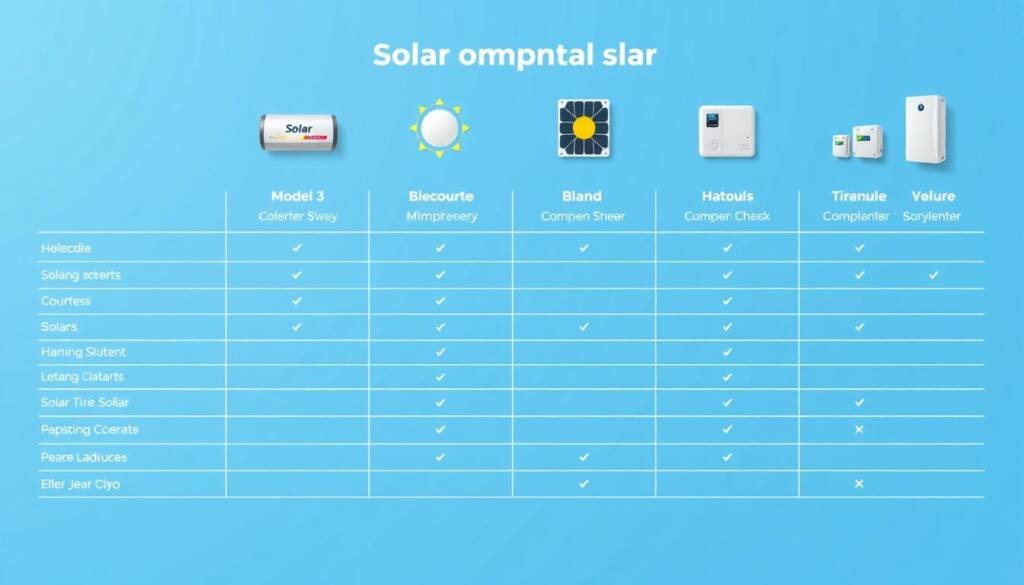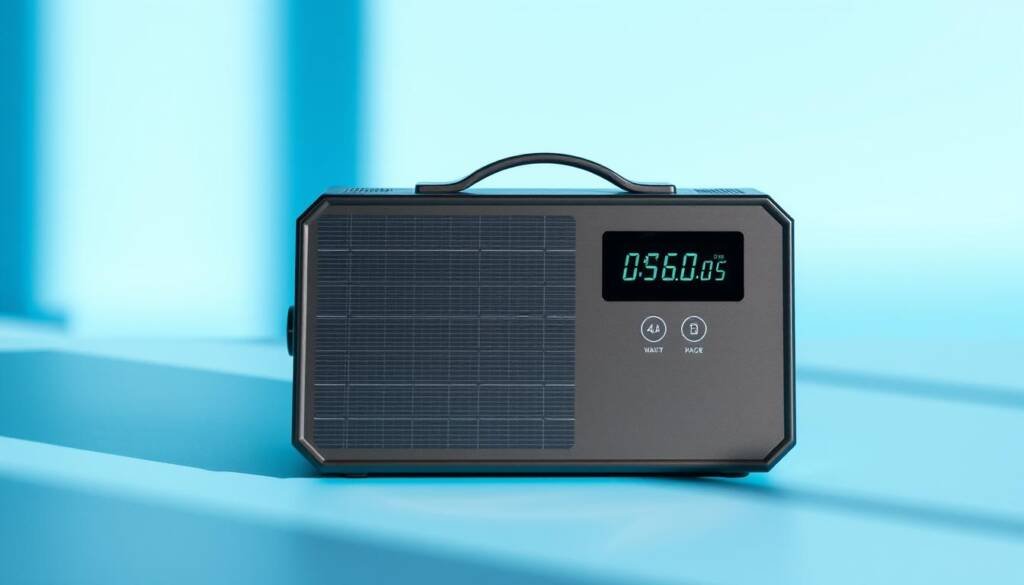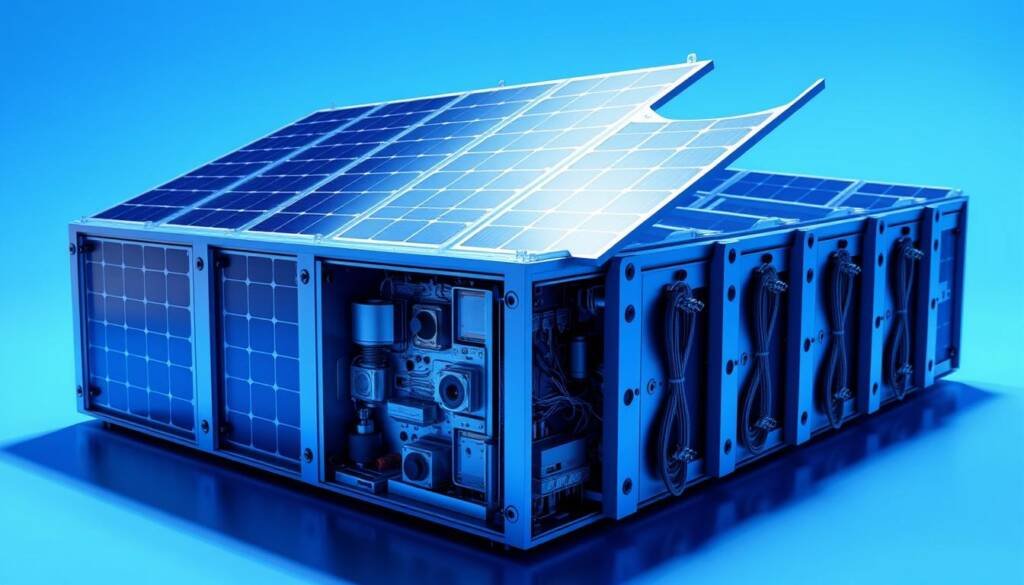Did you know that a single 6,000-watt solar-powered portable power station can run a refrigerator, lights, a furnace, and even a small central air-conditioning unit simultaneously? This striking capability showcases the immense potential of modern solar energy solutions. We’ve rigorously tested over 30 different models of portable power stations to bring you the most comprehensive guide on these renewable power sources.
Solar-powered portable power stations are revolutionizing how we access and use energy, especially in outdoor or emergency situations. These innovative devices combine high-capacity batteries with solar charging capabilities, offering a clean and sustainable alternative to traditional gas generators.
From compact units perfect for camping trips to robust systems capable of powering entire households, the range of available options is impressive. We’ve seen models with capacities spanning from 256Wh to a whopping 3840Wh, catering to diverse energy needs and preferences.
Our extensive testing revealed that top-tier solar-powered portable power stations, like the Anker Solix F3800, can output up to 6000W of power. This level of performance was unthinkable just a few years ago, demonstrating the rapid advancements in solar technology.
Price points for these eco-friendly energy solutions vary widely, with tested models ranging from $2,000 to $3,800. But don’t worry if that seems steep – we’ve also found effective options for smaller jobs priced at less than $200, making solar power accessible to a broader audience.
As we dive deeper into this guide, we’ll explore the best solar-powered portable power stations on the market, their key features, and how to choose the right one for your needs. Whether you’re an outdoor enthusiast, a remote worker, or simply looking for a reliable backup power source, this article will equip you with the knowledge to make an informed decision.
Key Takeaways
- Solar-powered portable power stations offer capacities from 256Wh to 3840Wh
- High-end models can power multiple household appliances simultaneously
- Prices range from under $200 for small units to $3,800 for large systems
- Most power stations provide standard 110-volt outlets and USB ports
- Advanced models offer expandable capacity and high output power
- Battery life cycles range from 3000 to 4000 charges, ensuring long-term use
- Weight varies significantly, from 40 to over 130 pounds, affecting portability
Introduction to Solar-Powered Portable Power Stations
Solar-powered portable power stations are revolutionizing off-grid energy solutions. These innovative devices combine solar panel technology with high-capacity batteries to create reliable, eco-friendly power sources. As the demand for sustainable energy grows, portable solar generators are becoming increasingly popular for outdoor enthusiasts and homeowners alike.
What are Solar Power Stations?
Solar power stations are compact units that store electrical energy in batteries and can be recharged using solar panels. These off-grid power stations typically include a battery, inverter, and various charging ports. They offer a clean alternative to traditional gas-powered generators, providing silent operation and zero emissions.
Benefits of Solar-Powered Solutions
Opting for solar-powered portable power stations brings numerous advantages:
- Reduced carbon footprint: Unlike gas generators that emit 1-2 lbs of CO2 per hour, solar generators produce zero emissions.
- Silent operation: Solar power stations operate quietly, a stark contrast to gas generators that can reach noise levels of 100 decibels.
- Long-term cost savings: While initial costs range from $300 to $5,000, solar generators offer significant savings over time.
- Versatility: These eco-friendly power solutions can function as standalone systems or integrate with home electrical panels for backup power.
- Durability: High-quality solar generators often come with warranties up to a decade, ensuring long-lasting performance.
By embracing portable solar generators, users contribute to sustainable energy practices while enjoying reliable power in various settings. These off-grid power stations represent a significant step towards a greener future in portable energy solutions.
Top Features to Consider in Solar-Powered Power Stations
When choosing energy-efficient solar chargers, several key features demand attention. We’ll guide you through the most important aspects to consider for compact solar power units.
Battery Capacity and Output
Battery capacity, measured in watt-hours (Wh), is crucial. For example, the EcoFlow Delta 2 Max boasts a 2,048Wh capacity, ideal for powering multiple devices. Output power, in watts, determines what you can run. The Delta 2 Max delivers a maximum output of 1,859W, suitable for most appliances.
Portability and Design
Weight and size are key for true portability. The Anker Solix C1000, weighing 28.4 pounds, strikes a balance between power and portability. Its 1,056Wh capacity offers ample power in a manageable package. For ultra-portability, the Anker Solix C300 at 9.1 pounds is perfect for short trips.
Charging Options and Compatibility
Versatile charging options enhance usability. Portable power stations offer various charging, including solar panels, AC outlets, and car chargers. The Jackery Explorer 880 exemplifies this versatility, compatible with multiple charging sources. Look for units with high solar input capacity for faster solar charging.
Consider these features when selecting your solar-powered portable power station to ensure it meets your energy needs and lifestyle demands.
Best Solar-Powered Portable Power Stations of 2023
Solar-powered portable power stations have revolutionized outdoor energy solutions. In 2023, several top brands offer impressive features for eco-conscious adventurers. Let’s explore some of the best solar-powered portable power stations available today.
Jackery Explorer Series
The Jackery Explorer 1000 stands out among outdoor solar power supplies. With a 1,002 Wh capacity, it can charge a laptop eight times or power a small fridge for over 15 hours. Weighing 22 pounds, it’s perfect for car camping. Charging options include 11.5 hours via car outlet, 6.5 hours with solar panels, or 5.5 hours through a wall outlet.
Goal Zero Yeti Series
The Goal Zero Yeti 500 is a compact powerhouse. At 16.1 pounds with 499 Wh capacity, it’s ideal for shorter trips. It charges in under 90 minutes via AC outlet or three hours with a 200W solar panel. For longer adventures, the Yeti 1500X boasts 1,516 Wh, powering a full-size fridge for 28 hours or charging a smartphone 127 times.
Bluetti AC200P
For those needing more power, the Bluetti AC200P delivers. With a whopping 2,000 Wh capacity, it’s a heavyweight at 62.4 pounds. Its rapid charging capabilities shine – reaching 80% in just 45 minutes. Solar enthusiasts will love its 2.5-hour recharge time under optimal conditions. Bluetti’s innovative features make it a top contender in the portable power station market.
These best solar-powered portable power stations offer a range of options for every outdoor need. From lightweight companions to robust power solutions, 2023’s lineup ensures you’ll never be left in the dark.
Comparing Different Brands and Models

When choosing solar energy solutions, it’s crucial to compare various brands and models. We’ve analyzed key factors to help you find the perfect renewable power source for your needs.
Performance Metrics
Solar-powered portable power stations vary in capacity and output. The EcoFlow Delta 2 Max offers a substantial 2,048 Wh capacity with a 1,800 W output, ideal for powering multiple devices. In contrast, the Anker Solix C1000 provides 1,056 Wh capacity with the same 1,800 W output, suitable for lighter usage.
Price Range
Prices for solar energy solutions span a wide range. Budget-friendly options start around $450, while high-end models can exceed $2,000. The Anker Solix C1000, priced at $600, offers good value for its features. The EcoFlow Delta 2 Max, at $1,000, provides higher capacity for those needing more power.
Customer Satisfaction
User reviews highlight reliability and portability as key factors. The Anker Solix C1000 receives praise for its compact size and 5-year warranty. EcoFlow Delta 2 Max users appreciate its expandable capacity and fast charging. Both brands score high in customer satisfaction for their renewable power sources.
- Anker Solix C1000: Lightweight at 28.4 pounds, 9-hour runtime
- EcoFlow Delta 2 Max: Heavier at 50.7 pounds, expandable to 6.144kWh
By comparing these aspects, you can find the solar-powered portable power station that best fits your specific energy needs and budget.
The Environmental Impact of Solar Power Stations
Solar-powered portable power stations are making waves in the world of eco-friendly power solutions. These innovative devices offer a cleaner alternative to traditional gas generators, significantly reducing carbon emissions and promoting sustainable energy practices.
Reducing Carbon Footprint
The adoption of solar power stations can lead to substantial reductions in carbon footprint. Unlike gas generators, which emit harmful carbon monoxide, solar power stations harness clean, renewable power sources. For instance, the Jackery Explorer 1000 V2 can power a 25-cubic-foot refrigerator for over 18 hours without any emissions.
Sustainable Energy Practices
Solar power stations encourage sustainable energy practices by utilizing the sun’s abundant energy. The EcoFlow 220W Bifacial Portable Solar Panel can generate up to 197 watts in direct sunlight, showcasing the potential of renewable power sources. This shift towards solar energy helps decrease reliance on fossil fuels and promotes a more sustainable future.
The life cycle of solar power stations also contributes to their eco-friendly nature. With manufacturers estimating battery lifespans between 1,000 to 10,000 discharge cycles, a quality solar power station could last up to 10 years with daily use. This longevity reduces waste and the need for frequent replacements, further minimizing environmental impact.
By choosing solar-powered portable power stations, consumers can play a crucial role in promoting eco-friendly power solutions and supporting the transition to cleaner, renewable power sources.
How to Choose the Right Solar Power Station for You

Selecting the best solar-powered portable power station requires a careful assessment of your energy needs. This process ensures you pick a unit that aligns with your lifestyle and power requirements.
Personal Energy Needs
Start by listing the devices you plan to power. Consider these common wattages:
- Smartphone: 2-6W
- Laptop: 30-200W
- Mini Fridge: 40-100W
- TV (32″ LED): 30-100W
Calculate your total power needs by multiplying each device’s wattage by its usage hours. Add a 10-25% buffer for inefficiencies. For example, if you need 220W for 4 hours, aim for at least 880Wh capacity.
Outdoor vs. Indoor Use
For outdoor adventures, prioritize compact solar power units with rugged designs and weather resistance. The Hinen 300W is ideal for charging phones and laptops during light outdoor use. For indoor backup power, focus on higher capacities and quiet operation. The Hinen 3000W can power multiple appliances during emergencies.
Consider selecting the right size portable power based on your specific needs. Small power stations (100-500Wh) suit short trips, while extra-large ones (3000Wh+) are perfect for off-grid living or RV use.
By evaluating your energy requirements and usage scenarios, you’ll be equipped to choose the best solar-powered portable power station that fits your needs perfectly.
Setting Up Your Solar-Powered Portable Power Station
Getting your solar energy solution up and running is easier than you might think. Let’s walk through the process of setting up and maintaining your outdoor solar power supply for optimal performance.
Step-by-Step Installation Guide
1. Unbox your solar power station and check all components.
2. Charge the unit fully using AC power before first use.
3. Connect solar panels to the power station using provided cables.
4. Place solar panels in direct sunlight, angled towards the sun for maximum efficiency.
Maintenance Tips
Keep your solar energy solution in top shape with these tips:
- Clean solar panels regularly with a soft cloth
- Check all connections for tightness and corrosion
- Store in a cool, dry place when not in use
- Perform a full charge cycle every 3-6 months
By following these steps, you’ll ensure your outdoor solar power supply stays reliable for years to come. Remember, proper setup and maintenance are key to maximizing the lifespan and efficiency of your solar-powered portable power station.
Using Your Solar Power Station Effectively
Getting the most out of your portable solar generator requires understanding best practices for charging and use. We’ll explore how to maximize efficiency and discuss different scenarios where off-grid power stations shine.
Best Practices for Charging
To keep your solar power station in top shape, maintain the battery charge between 20% and 80%. This range helps extend battery life. For optimal solar charging, position panels at the right angle and direction. Some advanced systems even track the sun’s movement to boost energy absorption.
Many portable solar generators offer multiple charging methods. The BLUETTI AC200MAX, for example, provides seven recharging options, including 900W max solar input and 1300W fast dual charging. This flexibility ensures you can power up in various situations.
Usage Scenarios: Camping vs. Home Backup
For camping trips, compact power stations like the Jackery Explorer 1000 Plus work well. With a 1264Wh capacity, it can charge most outdoor devices. When camping, prioritize essential gear and use energy-saving modes to extend battery life.
For home backup, larger units like the Jackery Solar Generator 5000 Plus offer whole-home solutions. These off-grid power stations can run critical appliances during outages. The BLUETTI AC300 kit, with its 3000W inverter and expandable battery, is another solid choice for home use.
Whether you’re powering a campsite or backing up your home, understanding your power needs and choosing the right solar generator ensures you’re never left in the dark.
Common Misconceptions About Solar Power Stations
Solar energy solutions have gained popularity, but myths still circulate. Let’s clear up some common misunderstandings about these eco-friendly power solutions.
Addressing Efficiency Concerns
Many believe solar power stations are inefficient. In reality, modern solar panels can achieve efficiency rates above 20%. A typical 400-watt panel can generate significant power during peak sunlight hours.
- Compact panels produce 150-200 watts
- High-efficiency panels deliver over 400 watts
- Performance varies with climate and placement
Misunderstanding Longevity and Durability
Some worry about the durability of solar power stations. Quality units are built to last, withstanding outdoor conditions for years. With proper care, these eco-friendly power solutions often outlast initial expectations.
The EcoFlow DELTA Pro, for example, can save more on electric bills than grid-tied systems by avoiding peak demand hours. This showcases the long-term benefits of investing in solar technology.
As the demand for clean energy grows, so does innovation. Global spending on solar technology reaches trillions, driving improvements in efficiency and durability. By understanding these facts, we can confidently embrace solar energy solutions for a sustainable future.
Future Trends in Solar-Powered Technology

The solar energy landscape is evolving rapidly, promising exciting advancements in renewable power sources. As technology progresses, we’re seeing remarkable improvements in efficiency, affordability, and accessibility of solar solutions.
Advances in Battery Technology
Battery technology is at the forefront of solar innovation. Solid-state batteries are emerging as game-changers, offering higher energy densities and faster charging times. These advancements could revolutionize energy-efficient solar chargers, making them more powerful and compact.
Lithium-ion batteries have seen significant improvements in capacity and lifespan. The development of flow batteries presents another promising avenue, potentially offering longer-term energy storage solutions for solar power systems.
Increasing Accessibility and Affordability
The cost of solar PV modules has plummeted by over 80% in the past decade. This dramatic price reduction is making renewable power sources more accessible to a broader range of consumers and businesses. Government incentives, such as tax credits and subsidies, further reduce installation costs and promote wider adoption.
Innovative financing options like leasing and power purchase agreements are eliminating upfront costs, making solar energy more attainable. Community solar projects are also on the rise, providing shared energy access and making solar power available to those who can’t install their own systems.
As production scales up and technology advances, we can expect energy-efficient solar chargers to become increasingly affordable and widely available. This trend toward accessibility is crucial in accelerating the global transition to sustainable energy solutions.
Conclusion: Embracing Eco-Friendly Energy Solutions
As we wrap up our guide to the best solar-powered portable power stations, it’s clear that these eco-friendly power solutions are revolutionizing how we think about energy. With the global market for portable power stations on the rise, driven by increasing demand for clean energy and off-grid options, we’re seeing a shift towards more sustainable practices.
The Future of Portable Power with Solar Technology
The future of portable power is bright with solar technology. Take the Jackery Solar Generator series, for example. The 500 model can power a typical home office setup for hours, while the 2000 Pro model, with its 2160Wh capacity, can handle high-capacity computers and multiple monitors. These advancements are making solar-powered portable power stations increasingly viable for diverse needs, from outdoor adventures to emergency preparedness.
Encouraging Sustainable Choices
By choosing the best solar-powered portable power stations, we’re not just investing in convenience – we’re investing in our planet’s future. Solar energy is 100% clean and renewable, reducing our reliance on fossil fuels. As more households and businesses adopt these eco-friendly power solutions, we’re collectively moving towards a more sustainable energy landscape. It’s time to harness the power of the sun and make a positive impact on our environment, one portable power station at a time.